coolant temperature RENAULT TWINGO RS 2009 2.G Engine And Peripherals User Guide
[x] Cancel search | Manufacturer: RENAULT, Model Year: 2009, Model line: TWINGO RS, Model: RENAULT TWINGO RS 2009 2.GPages: 652
Page 372 of 652
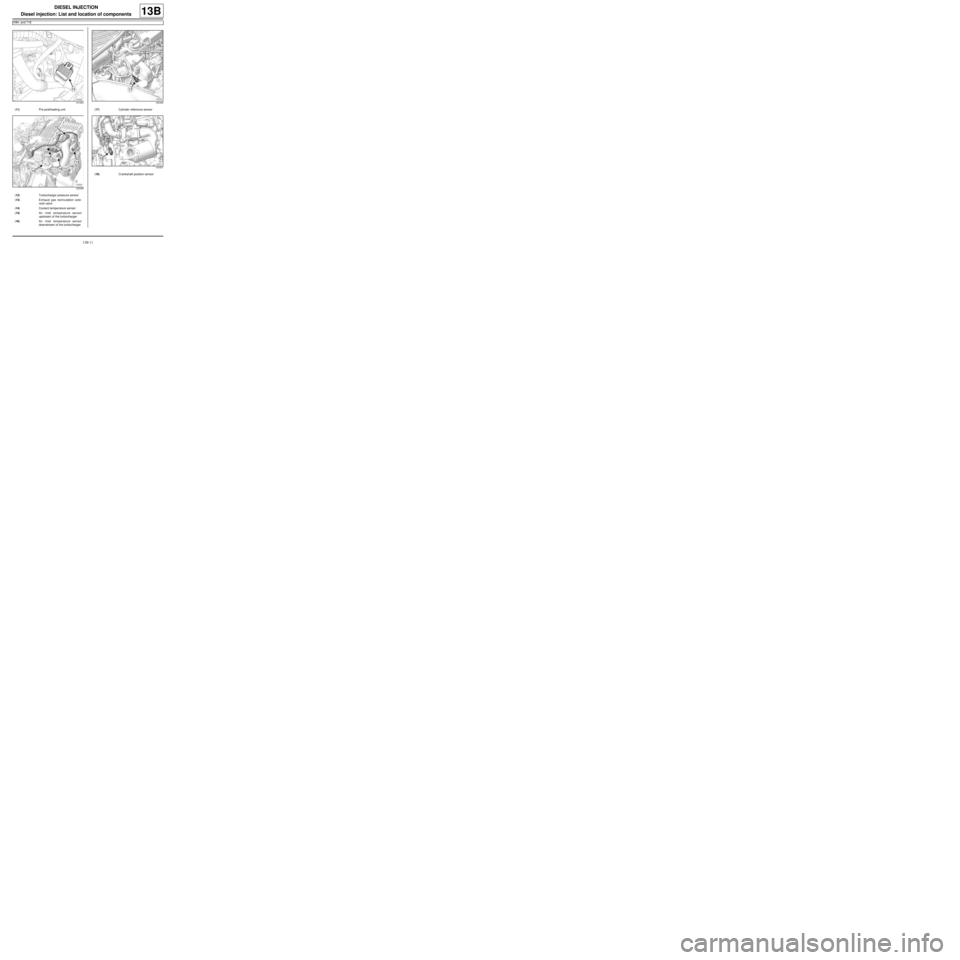
13B-11
DIESEL INJECTION
Diesel injection: List and location of components
K9K, and 718
13B
141220
(11) Pre-postheating unit
120039
(12) Turbocharger pressure sensor
(13) Exhaust gas recirculation sole-
noid valve
(14) Coolant temper ature sensor
(15) Air inlet temperature sensor
upstream of the turbocharger
(16) Air inlet temperature sensor
downstream of the turbocharger
120326
(17) Cylinder reference sensor
120327
(18) Crankshaft position sensor
Page 395 of 652
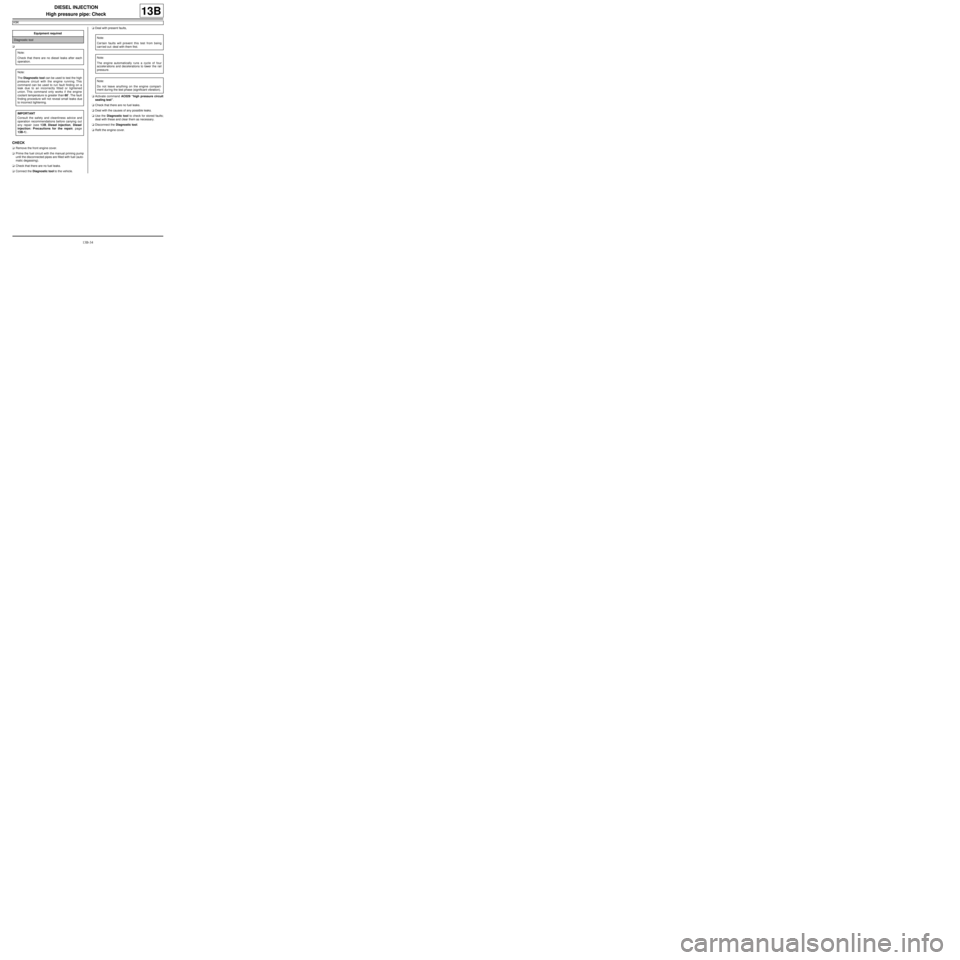
13B-34
DIESEL INJECTION
High pressure pipe: Check
K9K
13B
a
CHECK
aRemove the front engine cover.
aPrime the fuel circuit with the manual priming pump
until the disconnected pipes are filled with fuel (auto-
matic degassing).
aCheck that there are no fuel leaks.
aConnect the Diagnostic tool to the vehicle.aDeal with present faults,
aActivate command AC029 “high pressure circuit
sealing test”.
aCheck that there are no fuel leaks.
aDeal with the causes of any possible leaks.
aUse the Diagnostic tool to check for stored faults;
deal with these and clear them as necessary.
aDisconnect the Diagnostic tool.
aRefit the engine cover. Equipment required
Diagnostic tool
Note:
Check that there are no diesel leaks after each
operation.
Note:
The Diagnostic tool can be used to test the high
pressure circuit with the engine running. This
command can be used to run fault finding on a
leak due to an incorrectly fitted or tightened
union. This command only works if the engine
coolant temperature is greater than 60˚. The fault
finding procedure will not reveal small leaks due
to incorrect tightening.
IMPORTANT
Consult the safety and cleanliness advice and
operation recommendations before carrying out
any repair (see 13B, Diesel injection, Diesel
injection: Precautions for the repair, page
13B-1) .Note:
Certain faults will prevent this test from being
carr ied out: deal with them first.
Note:
The engine automatically runs a cycle of four
acceler ations and decelerations to lower the rail
pressure.
Note:
Do not leave anything on the engine compart-
ment dur ing the test phase (significant vibration).
Page 476 of 652
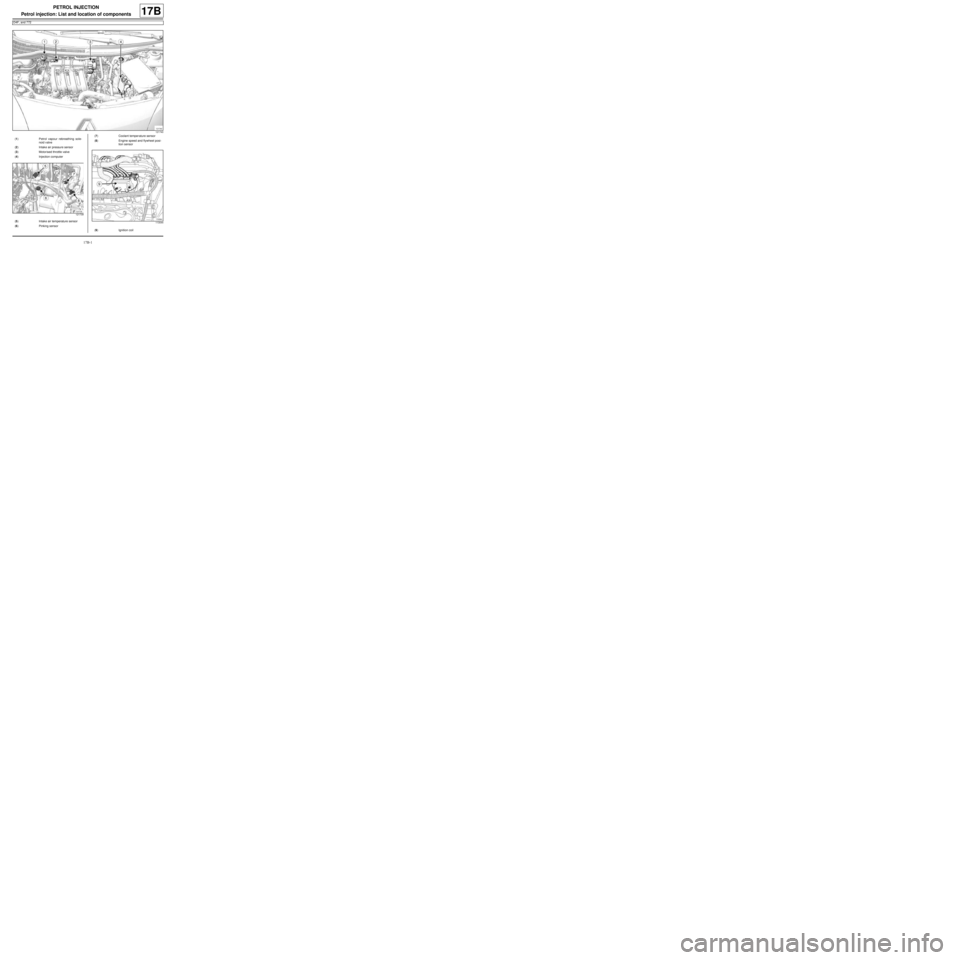
17B-1
PETROL INJECTION
Petrol injection: List and location of components
D4F, and 772
17B
121740
(1) Petrol vapour rebreathing sole-
noid valve
(2) Intake air pressure sensor
(3) Motorised throttle valve
(4) Injection computer
121739
(5) Intake air temperature sensor
(6) Pinking sensor
(7) Coolant temper ature sensor
(8) Engine speed and flywheel posi-
tion sensor
113044
(9) Ignition coil
Page 484 of 652
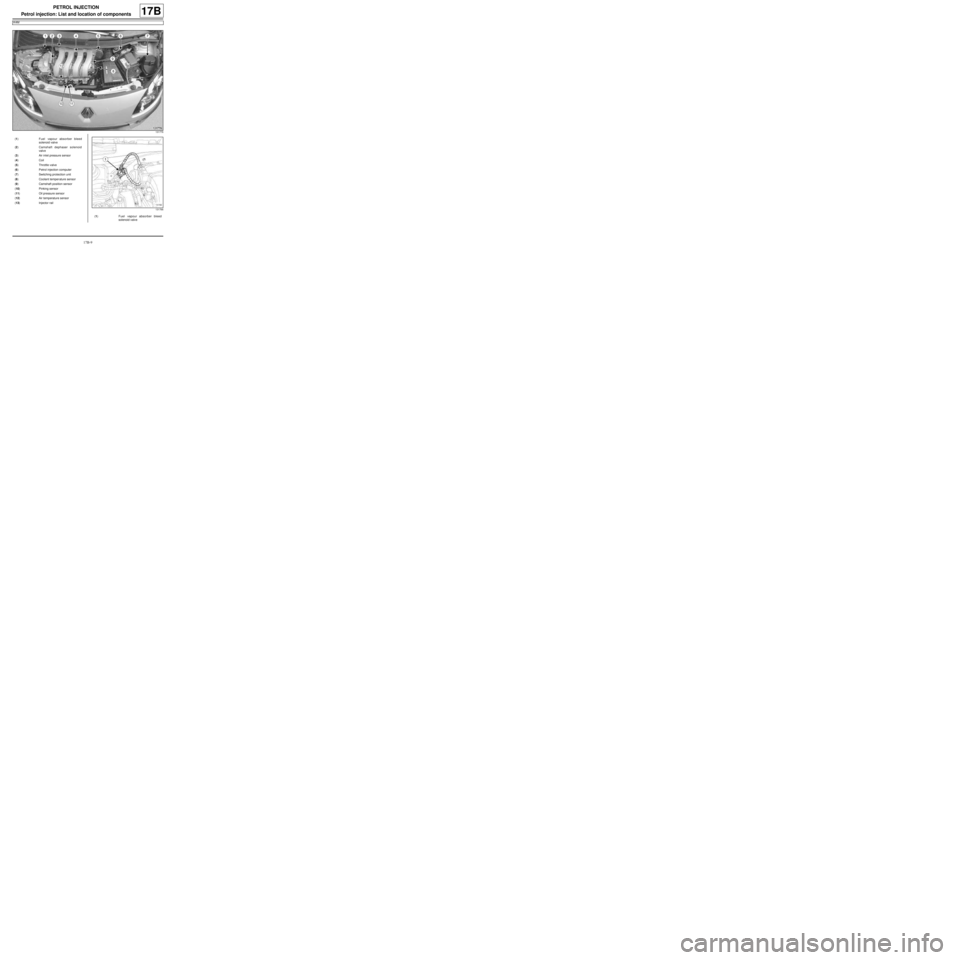
17B-9
PETROL INJECTION
Petrol injection: List and location of components
K4M
17B
131776
(1) Fuel vapour absorber bleed
solenoid valve
(2) Camshaft dephaser solenoid
valve
(3) Air inlet pressure sensor
(4) Coil
(5) Throttle valve
(6) Petrol injection computer
(7) Switching protection unit
(8) Coolant temper ature sensor
(9) Camshaft position sensor
(10) Pinking sensor
(11) Oil pressure sensor
(12) Air temperature sensor
(13) Injector rail
131766
(1) Fuel vapour absorber bleed
solenoid valve
Page 511 of 652
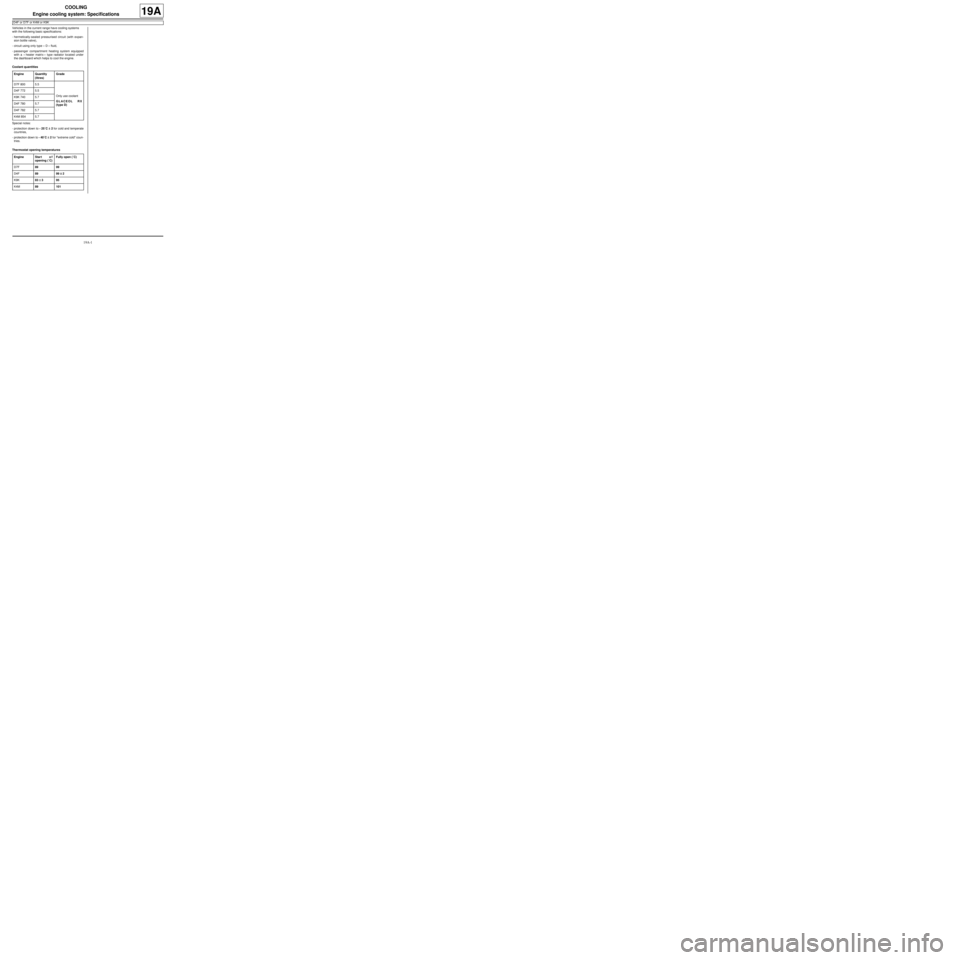
19A-1
COOLING
Engine cooling system: Specifications
D4F or D7F or K4M or K9K
19A
Vehicles in the current range have cooling systems
with the following basic specifications:
-hermetically-sealed pressurised circuit (with expan-
sion bottle valve),
-circuit using only type « D » fluid,
-passenger compartment heating system equipped
with a « heater matrix » type radiator located under
the dashboard which helps to cool the engine.
Coolant quantities
Special notes:
-protection down to - 25˚C ±± ± ±
2 for cold and temperate
countries,
-protection down to - 40˚C ±± ± ±
2 for "extreme cold" coun-
tries.
Thermostat opening temperaturesEngine Quantity
(litres)Grade
D7F 800 5.5
Only use coolant
GLACEOL RX
(type D) D4F 772 5.5
K9K 740 5.7
D4F 780 5.7
D4F 782 5.7
K4M 854 5.7
Engine Star t o f
opening (˚C)Fully open (˚C)
D7F89 99
D4F89 99 ±± ± ±
2
K9K83 ±± ± ±
395
K4M89 101
Page 554 of 652
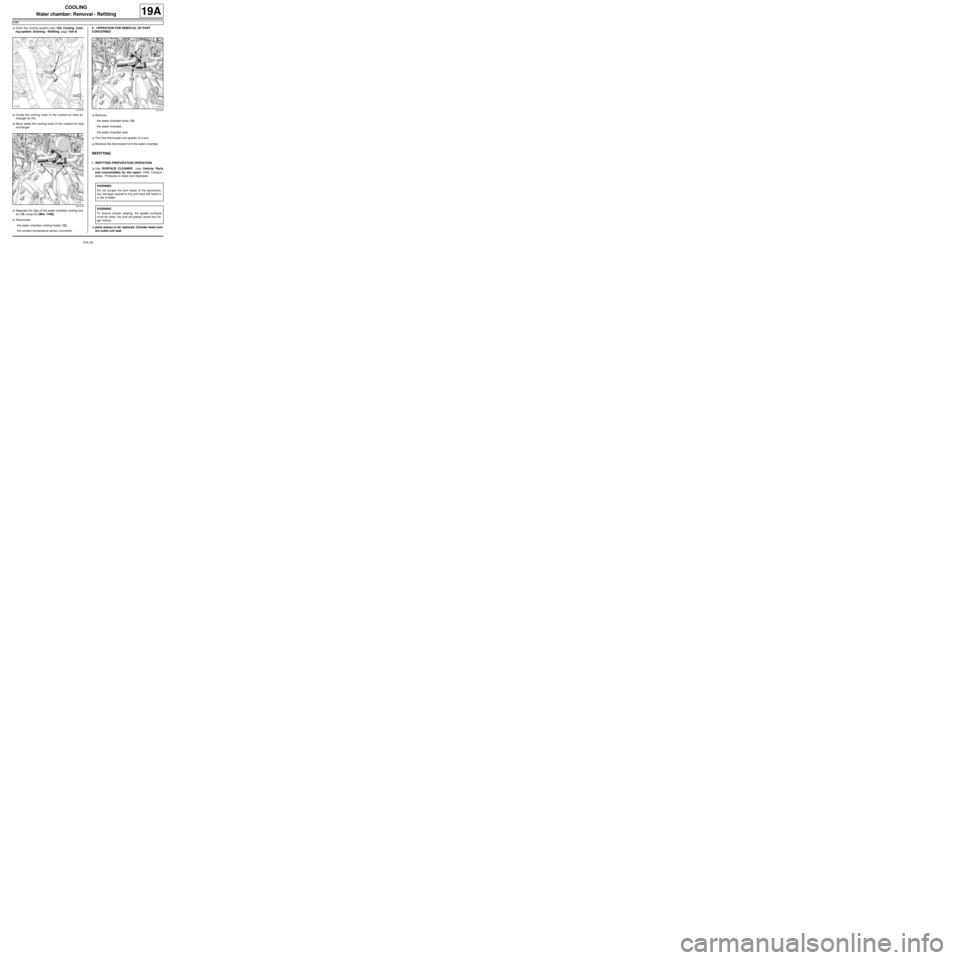
19A-44
COOLING
Water chamber: Removal - Refitting
K9K
19A
aDrain the cooling system (see 19A, Cooling, Cool-
ing system: Draining - Refilling, page 19A-9) .
aUnclip the cooling hose of the coolant-oil heat ex-
changer at (11) .
aMove aside the cooling hose of the coolant-oil heat
exchanger.
aSeparate the clips of the water chamber cooling hos-
es (12) using the (Mot. 1448).
aDisconnect:
-the water chamber cooling hoses (12) ,
-the coolant temperature sensor connector.II - OPERATION FOR REMOVAL OF PART
CONCERNED
aRemove:
-the water chamber bolts (13) ,
-the water chamber,
-the water chamber seal.
aTurn the thermostat one quarter of a turn.
aRemove the thermostat from the water chamber.
REFITTING
I - REFITTING PREPARATION OPERATION
aUse SURFACE CLEANER (see Vehicle: Parts
and consumables for the repair) (04B, Consum-
ables - Products) to clean and degrease.
aparts always to be replaced: Cylinder head cool-
ant outlet unit seal
141218
121416121416
WARNING
Do not scrape the joint faces of the aluminium,
any damage caused to the joint face will result in
a risk of leaks.
WARNING
To ensure proper sealing, the gasket surfaces
must be clean, dry and not greasy (avoid any fin-
ger mar ks).
Page 559 of 652
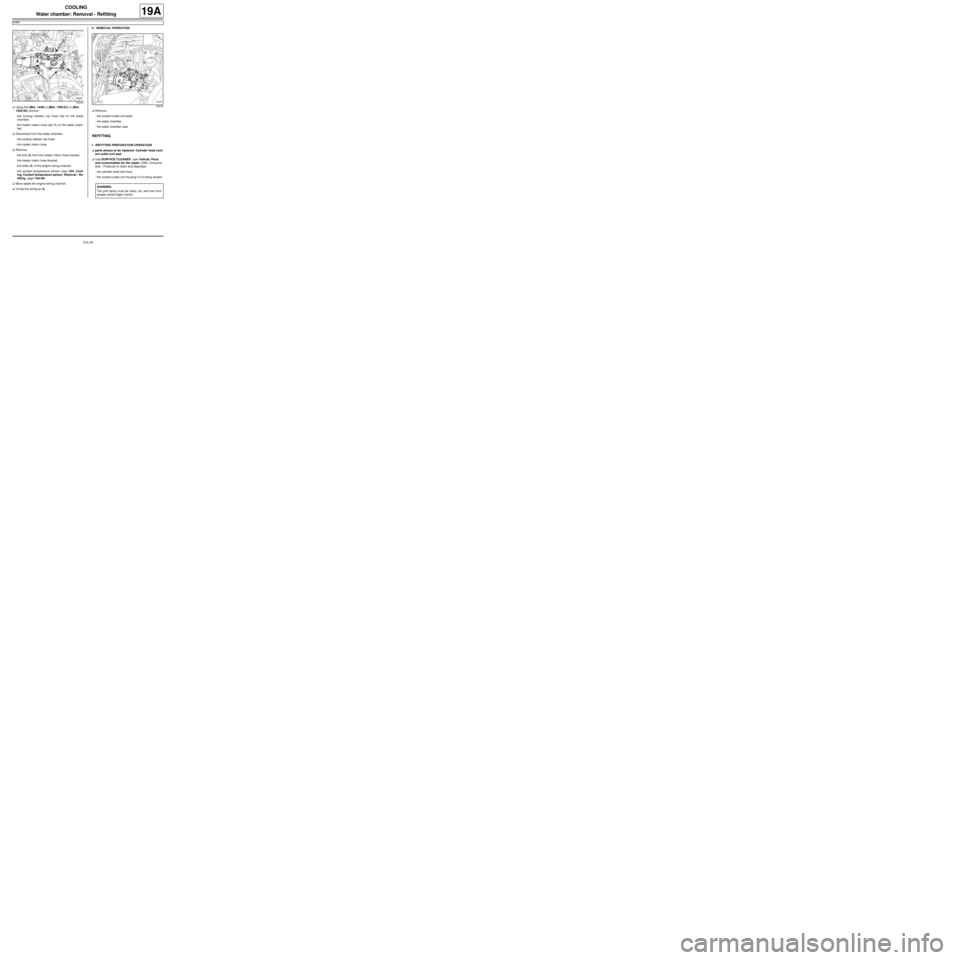
19A-49
COOLING
Water chamber: Removal - Refitting
K4M
19A
aUsing the (Mot. 1448) or (Mot. 1202-01) or (Mot.
1202-02) remove:
-the cooling radiator top hose clip on the water
chamber,
-the heater matrix hose clip (1) on the water cham-
ber.
aDisconnect from the water chamber:
-the cooling radiator top hose,
-the heater matrix hose.
aRemove:
-the bolt (2) from the heater matrix hose bracket,
-the heater matrix hose bracket,
-the bolts (3) of the engine wiring channel,
-the coolant temperature sensor (see 19A, Cool-
ing, Coolant temperature sensor: Removal - Re-
fitting, page 19A-66) .
aMove aside the engine wiring channel.
aUnclip the wiring at (4) .II - REMOVAL OPERATION
aRemove:
-the coolant outlet unit bolts,
-the water chamber,
-the water chamber seal.
REFITTING
I - REFITTING PREPARATION OPERATION
aparts always to be replaced: Cylinder head cool-
ant outlet unit seal.
aUse SURFACE CLEANER (see Vehicle: Parts
and consumables for the repair) (04B, Consuma-
bles - Products) to clean and degrease:
-the cylinder head joint face,
-the coolant outlet unit housing if it is being reused.
132444
128456
WARNING
The joint faces must be clean, dr y and free from
grease (avoid finger marks).
Page 560 of 652
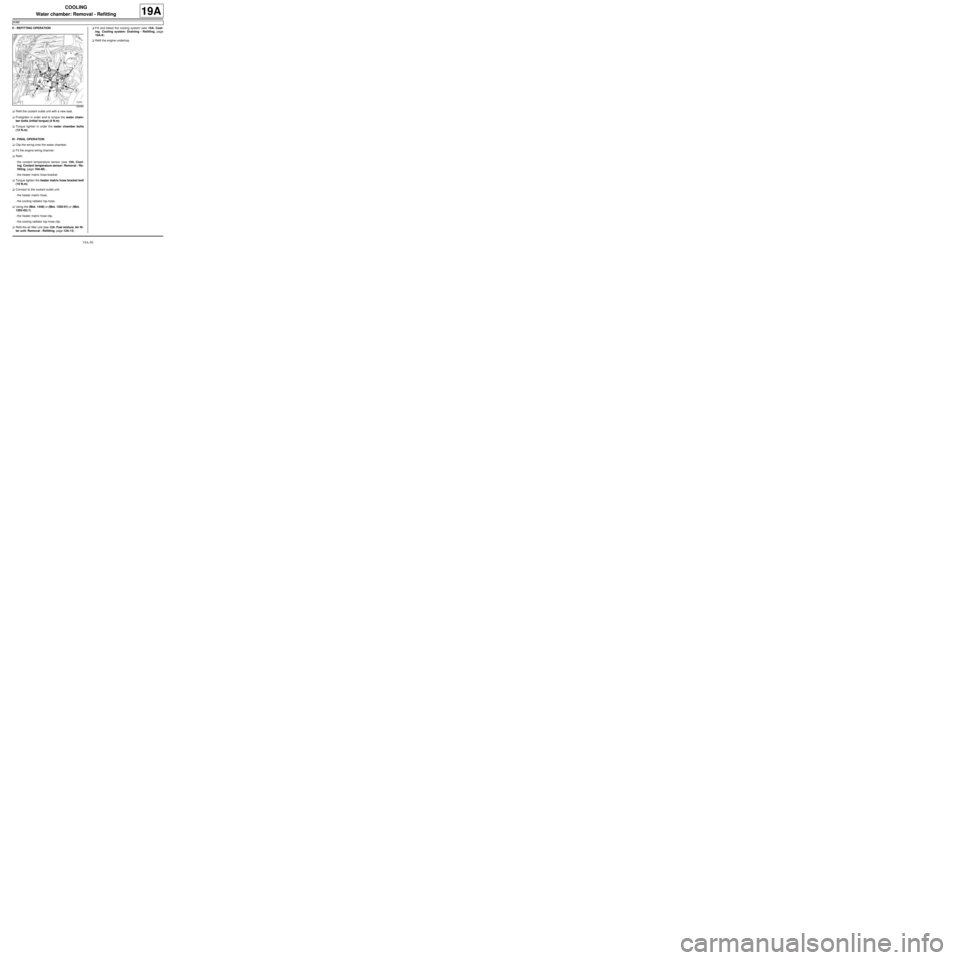
19A-50
COOLING
Water chamber: Removal - Refitting
K4M
19A
II - REFITTING OPERATION
aRefit the coolant outlet unit with a new seal.
aPretighten in order and to torque the water cham-
ber bolts (initial torque) (4 N.m).
aTorque tighten in order the water chamber bolts
(12 N.m).
III - FINAL OPERATION
aClip the wiring onto the water chamber.
aFit the engine wiring channel.
aRefit:
-the coolant temperature sensor (see 19A, Cool-
ing, Coolant temperature sensor: Removal - Re-
fitting, page 19A-66) ,
-the heater matrix hose bracket.
aTorque tighten the heater matrix hose bracket bolt
(10 N.m).
aConnect to the coolant outlet unit:
-the heater matrix hose,
-the cooling radiator top hose.
aUsing the (Mot. 1448) or (Mot. 1202-01) or (Mot.
1202-02) fit:
-the heater matrix hose clip,
-the cooling radiator top hose clip.
aRefit the air filter unit (see 12A, Fuel mixture, Air fil-
ter unit: Removal - Refitting, page 12A-13) .aFill and bleed the cooling system (see 19A, Cool-
ing, Cooling system: Draining - Refilling, page
19A-9) .
aRefit the engine undertray.
128456
Page 576 of 652

19A-66
COOLING
Coolant temperature sensor: Removal - Refitting
D4F or D7F
19A
PARTS AND CONSUMABLES FOR THE
REPAIR WORK
aParts always to be replaced :
-coolant temperature sensor seal.
aConsumable (see Vehicle: Parts and consuma-
bles for the repair) :
-COOLANT.
REMOVAL
I - REMOVAL PREPARATION OPERATION
aRemove the air filter unit (see 12A, Fuel mixture,
Air filter unit: Removal - Refitting, page 12A-13) .
II - OPERATION FOR REMOVAL OF PART
CONCERNED
aDisconnect the coolant temperature sensor connec-
tor (1) .
aRemove the coolant temperature sensor.
REFITTING
I - REFITTING OPERATION FOR PART
CONCERNED
aRefit:
-the new coolant temperature sensor seal,
-the coolant temperature sensor.
aTighten the coolant temperature sensor.
aConnect the coolant temperature sensor connector.
II - FINAL OPERATION
aRefit the air filter unit (see 12A, Fuel mixture, Air fil-
ter unit: Removal - Refitting, page 12A-13) .
aTop up the coolant fluid level.
aBleed the cooling system (see 19A, Cooling, Cool-
ing system: Draining - Refilling, page 19A-9) . D4F
114326
D4F
Page 577 of 652
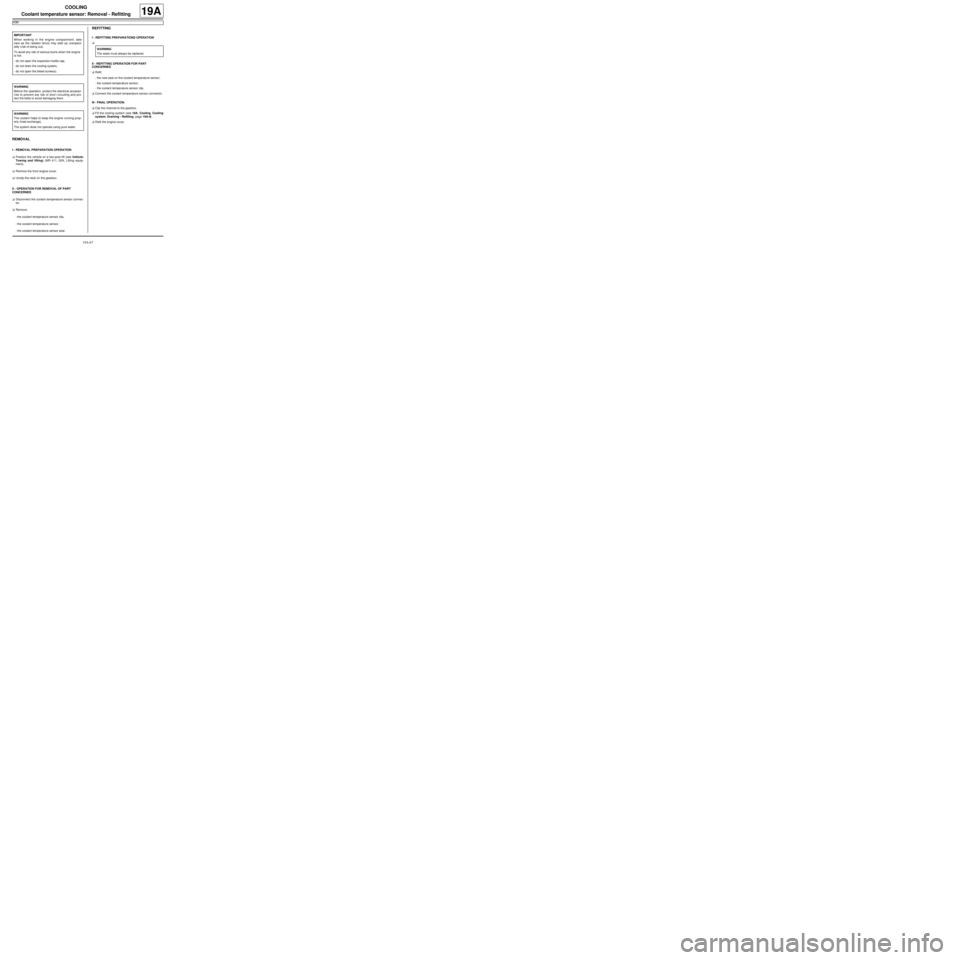
19A-67
COOLING
Coolant temperature sensor: Removal - Refitting
K9K
19A
REMOVAL
I - REMOVAL PREPARATION OPERATION
aPosition the vehicle on a two-post lift (see Vehicle:
Towing and lifting) (MR 411, 02A, Lifting equip-
ment).
aRemove the front engine cover.
aUnclip the neck on the gearbox.
II - OPERATION FOR REMOVAL OF PART
CONCERNED
aDisconnect the coolant temperature sensor connec-
tor.
aRemove:
-the coolant temperature sensor clip,
-the coolant temperature sensor,
-the coolant temperature sensor seal.
REFITTING
I - REFITTING PREPARATIONS OPERATION
a
II - REFITTING OPERATION FOR PART
CONCERNED
aRefit:
-the new seal on the coolant temperature sensor,
-the coolant temperature sensor,
-the coolant temperature sensor clip.
aConnect the coolant temperature sensor connector.
III - FINAL OPERATION.
aClip the channel to the gearbox.
aFill the cooling system (see 19A, Cooling, Cooling
system: Draining - Refilling, page 19A-9) .
aRefit the engine cover. IMPORTANT
When working in the engine compartment, take
care as the radiator fan(s) may start up unexpect-
edly (risk of being cut).
To avoid any risk of serious burns when the engine
is hot:
-do not open the expansion bottle cap,
-do not drain the cooling system,
-do not open the bleed screw(s).
WARNING
Before the operation, protect the electrical accesso-
ries to prevent any risk of shor t circuiting and pro-
tect the belts to avoid damaging them.
WARNING
The coolant helps to keep the engine running prop-
erly (heat exchange).
The system does not operate using pure water.
WARNING
The seals m ust always be replaced.